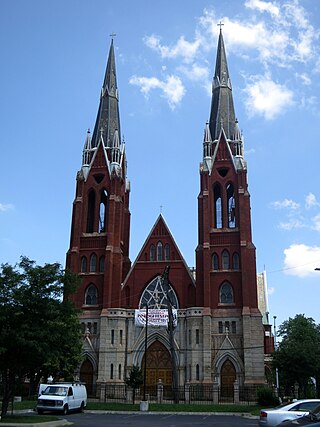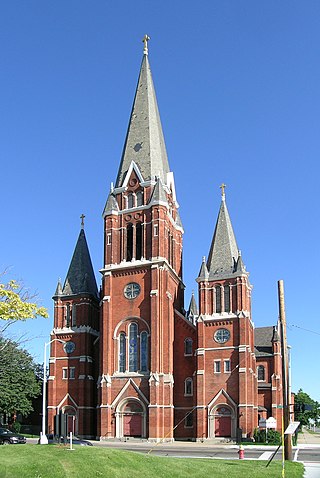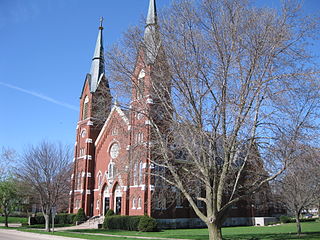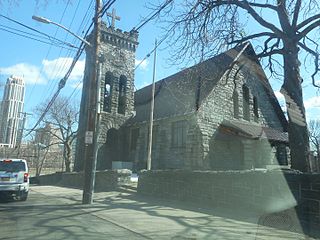
Saint Mary's Catholic Church is a former parish of the Archdiocese of Dubuque. The church is located in Dubuque, Iowa, United States, at the corner of 15th and White Streets. The church is recognizable by its steeple– one of the tallest in the area. The church property was added to the National Register of Historic Places as an historic district in 2015, and the various buildings were included as contributing properties in the Washington Residential Historic District later in the same year.

The Holy Name of Jesus Roman Catholic Church is a parish church of the Roman Catholic Archdiocese of New York located at 207 West 96th Street at the corner of Amsterdam Avenue in the Upper West Side neighborhood of Manhattan, New York City. It was built in 1900 and was designed by Thomas H. Poole in the Gothic Revival style.

St. Mary Star of the Sea Catholic Church is a parish of the Roman Catholic Church located in downtown Jackson, Michigan, in the Diocese of Lansing. It is dedicated to Our Lady, Star of the Sea. In 2008 it absorbed the congregations of St. Stanislaus Kostka Chapel and the Chapel of Sacred Heart, also in Jackson.

Our Lady of the Scapular Parish is a Roman Catholic personal parish that specifically ministers to Polish immigrants and those of Polish descent. Our Lady of the Scapular Parish was established on August 1, 2013, as a result from a merger of Our Lady of Mount Carmel Parish (1899–2013) and St. Stanislaus Kostka Parish (1914–2013). The activities of the parish are located at Our Lady of Mount Carmel Catholic Church in Wyandotte, Michigan, Wayne County, United States.

St. Michael is a church of the Roman Catholic Archdiocese of Chicago. The current church is located at E. 83rd Street and S. South Shore Drive in South Chicago, a neighborhood of Chicago, Illinois.

Holy Family Catholic Church is a Catholic parish located on Elk Avenue in Glendale, California that consists of a Catholic church, an elementary school and an all-girls high school. Founded in 1907, it is the oldest parish in Glendale.

Mary Star of the Sea Catholic Church is a Roman Catholic parish located in San Pedro, California, dedicated to Our Lady, Star of the Sea. Located on a hill overlooking the Port of Los Angeles, Mary Star of the Sea has sometimes been known as the "Fishermen’s Parish" because of its close ties with the fishing and cannery community in San Pedro. Established in 1889, the parish is one of the oldest in the Los Angeles Archdiocese. The present church, built in 1958, is the third church to serve the parish.

St. William is a US Catholic parish founded in January 1920 in the Philadelphia Pennsylvania neighborhood of Lawncrest. The parish originally served 70 households. The Parish elementary school was opened in 1924. The parish eventually expanded to include a rectory, convent, kindergarten, lower school, junior high school, day care center, parish hall and the two churches. The school, which reached a peak enrollment of 1,586 students in 1964, closed on June 15, 2012 with a final enrollment of 280 students. As of 2019, the church served 1,830 households totaling 5,080 people and Mass attendance currently averages 1,300 people, spread among the 8 Sunday Masses.

The Sweetest Heart of Mary Roman Catholic Church is located at 4440 Russell Street in Detroit, Michigan, in the Forest Park neighborhood on the city's central East side. The Gothic Revival cathedral styled church is the largest of the Roman Catholic churches in the City of Detroit. It was designated a Michigan State Historic Site in 1974 and listed on the National Register of Historic Places in 1978. It, along with St. Albertus Roman Catholic Church, 0.4 miles east on East Canfield Street, and St. Josaphat Roman Catholic Church, 0.3 miles west at East Canfield Street and Chrysler Drive, served the large Polish community through most of the twentieth century. In a diocesan reorganization instituted by Archbishop Allen Vigneron in 2013, Sweetest Heart of Mary joined with St. Josephat to form Mother of Divine Mercy Parish.

St. Josaphat Roman Catholic Church is a Roman Catholic church located at 715 East Canfield Street in Detroit, Michigan. It was listed on the National Register of Historic Places in 1982 and designated a Michigan State Historic Site in 1985. Since 2013, it has been one of two churches that comprise Mother of Divine Mercy Parish.

St. Mary's Catholic Church, also known as St. Mary of the Visitation Church, is a parish church of the Diocese of Davenport which is located in Iowa City, Iowa, United States. The church building and rectory were listed together on the National Register of Historic Places in 1980. They were both included as contributing properties in the Jefferson Street Historic District in 2004. The parish's first rectory, which is now a private home, is also listed on the National Register as St. Mary's Rectory. It is located a few blocks to the east of the present church location at 610 E. Jefferson St.

St. Henry's Catholic Church is an historic Roman Catholic church in St. Henry, Ohio, United States. Built in the late nineteenth century, it remains the home of a functioning congregation, and it has been recognized as a historically significant building because of its architecture.

St. Basil's Church, built in 1856, is the founding church of the Congregation of St. Basil in Toronto, Ontario, Canada, the college church of St. Michael's College, Toronto, and a parish church serving a large local congregation.

St. Aloysius Catholic Church is a historic Roman Catholic church in Carthagena, an unincorporated community in Marion Township, Mercer County, Ohio, United States. Built in the late nineteenth century, it remains the home of an active parish, and it has been designated a historic site because of its well-preserved architecture.

St. Boniface Church is a former parish church of the Diocese of Davenport. The church was founded in the town of Lyons, which is now the north side of Clinton, Iowa, United States. The church building is now a museum named The Catholic Historical Center at St. Boniface, with exhibits about the history of the Clinton area Catholic community, and an archive of local Catholic church artifacts and records. The church was listed on the National Register of Historic Places in 2012.

The Parish of St. Gabriel and of St. Joseph was formed in August 2015 with the merger of the Territorial parish of St. Gabriel on Division Street with the personal parish of St. Joseph on Washington Avenue, both in New Rochelle, NY. St. Gabriel is the parish church. However, St. Joseph "will maintain a regular schedule of Masses and the celebration of other sacraments". Both parishes were established around 1900 through the generosity of the Iselin family.

St Thomas of Canterbury Church is a Roman Catholic Parish church in Canterbury, Kent, England. It was built from 1874 to 1875 in the Gothic Revival style. It is situated on the corner of Burgate and Canterbury Lane, west of Lower Bridge Street, opposite the grounds of Canterbury Cathedral in the centre of the city. It is the only Roman Catholic church in Canterbury, built on the site of a medieval church ; the old St Mary Magdalen’s Tower was retained. The church contains relics of Thomas Becket.

Saint John the Baptist Catholic Church is a parish of the Roman Catholic Church in Silver Spring, Maryland, United States. It was established by the Archdiocese of Washington in 1960, and is dedicated to John the Baptist.
St. Mary Parish Church is a Roman Catholic church in Westphalia, Michigan. The parish is part of the Roman Catholic Diocese of Lansing. Along with the church, St. Mary Parish facilities include an elementary school, youth center, funeral chapel, parish center, cemetery, rosary garden, and parish offices.
























